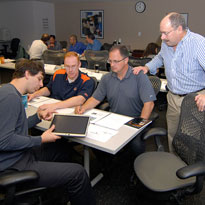Voice Communications for 911 Personnel
- Course:Voice Communications for 911 Personnel
- Course ID:VOICE-911 Duration:2-3 days Where: Your Office (7+ Persons)
- Download Course Description (PDF)
Available as a private, customized course for your group at your offices or ours and in some cases as a WebLive(TM) class.
Course Outline
- Introduction: Why Should a PSAP Care?
- Overview
- Family Tree of Telephony
- Conventional Calls
- Cellular/Wireless
- VoIP
- Fixed
- Nomadic
- Mobile/802.x
- Hybrid Cellular/802.x
- Technical Background
- Analog Transmission
- Digital Transmission
- Binary Number System
- Binary Encoding: Hand Codes, ASCII
- Circuits
- Bit Path
- Timing
- Synchronization
- Time Division Multiplexing
- T1/DS1
- Framing/Frame Format
- Time Slots
- PSAP Capacity
- Packet Switching
- Packet Format: Header, Payload, Trailer
- IP
- Packet QoS/QoE
- Best Effort
- Transmission of Human Speech
- Human/Musical Instrument Model
- Analog
- Digital
- PCM
- LPC
- Loss
- Packet Loss
- Sample Loss
- Coding Loss
- 911 End-to-End
- Conventional
- Cellular/Wireless
- VoIP: NENA I1, NENA I2, NENA I3
- VoIP Protocol
- PSAP Procedures
- MSAG and Location Issues
- VoIP Issues
- Lack of Hand-offs
- VoIP Is Not Traditional Telephony, Just Cheaper.
- Inconsistent Call Routing
- Missing or Inaccurate ANI/ALI
- Voice Quality Ranges Substantially.
- Misinterpretation of Whispers, Soft Sounds, and Background Noise
- Non-transmission of Whispers, Soft Sounds, and Background Noise
- Misinterpretation of Non-Human Sounds
- Quality Degradation during Heavy Call Volumes
- Evidentiary Issues Related to Recordings of VoIP Calls
- Power Failure and Battery-Backup Option, Does Not Work During Power Outages
- Use of Mobile Wireless VoIP and Location Issues
- Fraudulent and Misleading Use of VoIP – Bombing and SWATing
- Lack of Clarity in VoIP Standards
- Training on IP, VoIP and Related Technologies
- PSAP Best Practices
Course in a Nutshell
The rapid rise of cellular and then VoIP as means of accessing 911 and other emergency calling systems globally require call takers to better understand the underlying technologies and their impact on the quality and content of the emergency calls they handle. One side effect of cellular and VoIP is that it has revealed great misunderstandings and lack of knowledge of how emergency calls should be interpreted when received from conventional telephone systems.
This course, based upon training delivered to several thousand emergency services professionals in the US, Canada, and Australia over the past five years will equip call takers, supervisors, and trainers to better handle conventional, cellular, and wireless calls. Many emergency number professionals review the outline and course materials and ask, “Do I really need to know all this to answer emergency calls?” Upon closer examination, the conclusion reached by many of them is “Yes, I do”.
Customize It!
We can adapt this course to your group’s background and work requirements at little to no added cost. Let us know how we can tailor this course to your specific needs
Aimed At
Professionals who take emergency calls or those who supervise or train the 911 call takers
Prerequisites
You should have knowledge of the US or Canadian 911 systems or another emergency calling system, standard operating procedures for call takers, and a basic understanding of the process of accessing 911 and dispatching police, fire, EMS, and other emergency services.

